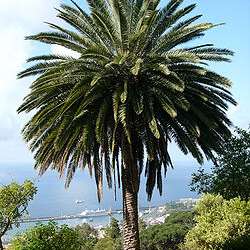Phoenix canariensis, the Canary Island palm or Canary Island palm, is a species of palm endemic to the Canary Islands. Due to its beauty, ease of adaptation and resistance to cold, it is one of the palm trees that is most used in gardening. It is a protected species on the islands of origin. The Canary Island palm tree is considered, according to a law of the Government of the Canary Islands, the natural symbol of the Canary Archipelago, together with the Canary Islands.
Large palm tree, with a thick and very leathery trunk (stipe), its leaves (palms) in dense webbed tufts, can measure between 2 and 3 meters long. The flowers are arranged in dense orange clusters. Fruits smaller than dates.
They are solitary palms, reaching a size of 10–13 m high and 50–70 cm in diameter, armed; thick stems with persistent leaf sheaths; dioecious plants. Leaves pinnate, numerous, 5–7 m long, the upper ones erect, the lower ones pendulous or arched; Pinnae in number of 150 pairs, arranged at different angles, the lower ones modified in the manner of acanthophylls; sheath 150 cm long, forming a fibrous network. Interfoliar inflorescences, once branched, 100 cm long, axillary, much shorter than the leaves, inconspicuous bracts; rachilla unbranched, numerous, arranged in a spiral, yellow-orange, sepals connate in a low dome; whitish staminate flowers, valvate petals, stamens 6, pistilodium absent; globose pistillate flowers, imbricate petals, staminodes generally 6, carpels free, follicular. Fruits generally developing from a single carpel, ovoid, 2–3 cm long, orange-yellowish, apical stigmatic residue, smooth epicarp, fleshy mesocarp, membranous endocarp; conspicuously ribbed seed, homogeneous endosperm, simple eophilic.
In the Canary Islands there is a multitude of uses of the different parts of the palm tree, now partially in disuse. On the island of La Gomera, the sap called guarapo is extracted to produce the Palm Honey. It produces edible fruits called támaras that are similar to the dates of Phoenix dactylifera, but smaller in size and lower quality for the palate. The leaves are used as brooms, it is common to see the island sweepers use them as a work tool.
